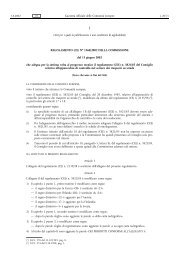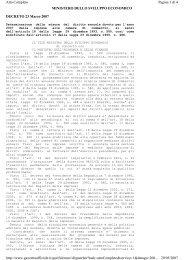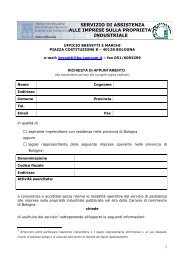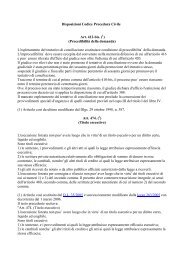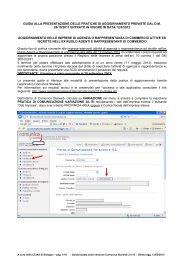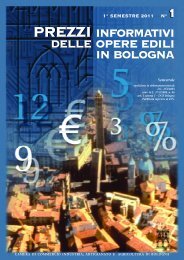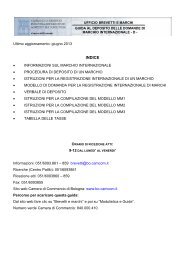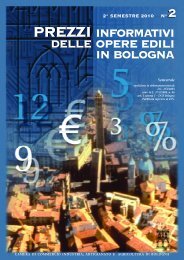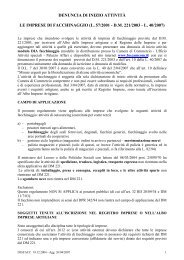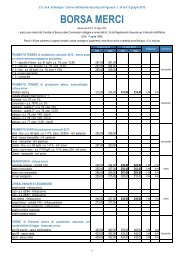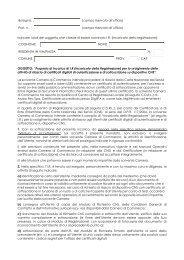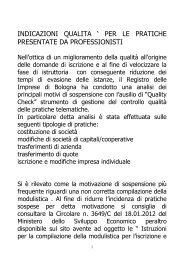al bando la sfiducia - Camera di Commercio di Bologna - Camere di ...
al bando la sfiducia - Camera di Commercio di Bologna - Camere di ...
al bando la sfiducia - Camera di Commercio di Bologna - Camere di ...
Create successful ePaper yourself
Turn your PDF publications into a flip-book with our unique Google optimized e-Paper software.
BOECO05N02_agosto 16-09-2005 17:25 Pagina 20<br />
BOLOGNA<br />
economica<br />
Perio<strong>di</strong>co del<strong>la</strong> <strong>Camera</strong> <strong>di</strong> <strong>Commercio</strong> Industria Artigianato e Agricoltura PREVIDENZA<br />
Settembre 2005<br />
Commercianti, è l’ora dei contributi<br />
Puntu<strong>al</strong>e come sempre l’INPS ha fornito<br />
le istruzioni per il pagamento dei contributi<br />
da parte degli esercenti attività commerci<strong>al</strong>i<br />
(fra cui rientrano anche gli agenti<br />
e i rappresentanti <strong>di</strong> commercio). An<strong>di</strong>amo<br />
a vedere come stanno le cose per l’anno<br />
in corso, rammentando innanzi tutto<br />
che a partire d<strong>al</strong> 16 maggio è iniziata <strong>la</strong><br />
serie <strong>di</strong> scadenze collegate <strong>al</strong> pagamento<br />
dei contributi previdenzi<strong>al</strong>i. La circo<strong>la</strong>re n.<br />
36 del 25 febbraio 2005 ci ricorda innanzi<br />
tutto che gli appuntamenti possibili sono<br />
sette, come negli anni passati:<br />
– quattro (16 maggio, 16 agosto e 16<br />
novembre del 2005, più il 16 febbraio<br />
2006) per il versamento delle rate dovute<br />
sul “minim<strong>al</strong>e”;<br />
– due (giugno e novembre) per il pagamento<br />
sul red<strong>di</strong>to eccedente il “minim<strong>al</strong>e”;<br />
– l’ultimo (previsto per giugno), re<strong>la</strong>tivo <strong>al</strong><br />
“conguaglio”.<br />
Circa le ultime tre scadenze occorre per<strong>al</strong>tro<br />
tener presente che esse coincidono in<br />
re<strong>al</strong>tà con i termini <strong>di</strong> pagamento dell’IRPEF<br />
(primo acconto, secondo acconto e s<strong>al</strong>do<br />
fin<strong>al</strong>e). Per comprendere il complesso<br />
sistema degli obblighi previdenzi<strong>al</strong>i, ricor<strong>di</strong>amo<br />
che gli esercenti attività commerci<strong>al</strong>i<br />
sono tenuti a versare un contributo<br />
annuo commisurato <strong>al</strong> red<strong>di</strong>to d’impresa<br />
<strong>di</strong>chiarato ai fini IRPEF. Poiché tuttavia <strong>la</strong><br />
<strong>di</strong>chiarazione dei red<strong>di</strong>ti si presenta l’anno<br />
dopo per l’anno prima (con l’UNICO 2005,<br />
ad esempio, si <strong>di</strong>chiarano i red<strong>di</strong>ti prodotti<br />
nel 2004), i conti per l’INPS si fanno sul<strong>la</strong><br />
base dell’ultima <strong>di</strong>chiarazione presentata,<br />
provvedendo poi – <strong>di</strong> norma nel giugno<br />
dell’anno successivo – <strong>al</strong>l’eventu<strong>al</strong>e “conguaglio”,<br />
che può essere a debito o a cre-<br />
Le istruzioni dell’INPS riguardano gli esercenti attività<br />
commerci<strong>al</strong>i, tra cui rientrano anche gli agenti e i<br />
rappresentanti <strong>di</strong> commercio e in<strong>di</strong>cano sette<br />
appuntamenti per i versamenti re<strong>la</strong>tivi <strong>al</strong> 2005<br />
<strong>di</strong>to. In pratica un agente <strong>di</strong> commercio<br />
(figura che utilizziamo a titolo d’esempio)<br />
si basa sul red<strong>di</strong>to re<strong>al</strong>e dell’anno precedente,<br />
utilizzandolo come red<strong>di</strong>to presunto<br />
per l’anno in corso. Per procedere ai conteggi<br />
(ed ai re<strong>la</strong>tivi versamenti) sono<br />
necessari tre dati:<br />
a) l’<strong>al</strong>iquota percentu<strong>al</strong>e da applicare;<br />
b) il “minim<strong>al</strong>e” ed il “massim<strong>al</strong>e”;<br />
c) il red<strong>di</strong>to d’impresa, che costituisce <strong>la</strong><br />
base <strong>di</strong> c<strong>al</strong>colo.<br />
Circa <strong>la</strong> percentu<strong>al</strong>e, essa ammonta, per il<br />
2005 <strong>al</strong> 17,59% (1). Ciò significa che un<br />
agente <strong>di</strong> commercio dovrà preventivare<br />
un esborso pari <strong>al</strong> 17,59% dei red<strong>di</strong>ti d’impresa<br />
che risulteranno complessivamente<br />
prodotti nel 2005. A partire d<strong>al</strong> 1993, infatti,<br />
il contributo INPS è c<strong>al</strong>co<strong>la</strong>to sul<strong>la</strong> tot<strong>al</strong>ità<br />
dei red<strong>di</strong>ti d’impresa denunciati ai fini<br />
IRPEF (e non più soltanto su quelli derivanti<br />
d<strong>al</strong>l’attività che dà titolo <strong>al</strong>l’iscrizione nel<strong>la</strong><br />
gestione <strong>di</strong> appartenenza). Se l’agente Zeta<br />
producesse nel 2005 un red<strong>di</strong>to d’impresa<br />
pari a 20.000 euro, dovrebbe dunque conteggiare<br />
e versare complessivamente il<br />
17,59% <strong>di</strong> t<strong>al</strong>e somma. E se invece producesse,<br />
durante l’intero anno solo 10.000<br />
euro, dovrebbe forse dovuto pagare il<br />
17,59% <strong>di</strong> t<strong>al</strong>e cifra? No, perché l’INPS, <strong>di</strong><br />
anno in anno, fissa il cosiddetto “minim<strong>al</strong>e”,<br />
cioè un red<strong>di</strong>to presunto sotto <strong>la</strong> cui<br />
soglia non è possibile scendere. Per il 2005<br />
il “minim<strong>al</strong>e” è pari ad euro 13.133,00 che<br />
corrispondono ad euro 2.310,09 (cioè <strong>al</strong><br />
17,59% <strong>di</strong> euro 13.133,00) da versare con<br />
le mod<strong>al</strong>ità sopra ricordate. E se il nostro<br />
agente iniziasse l’attività in ottobre? In t<strong>al</strong><br />
caso il suo minim<strong>al</strong>e sarebbe costituito da<br />
un quarto (3.112) <strong>di</strong> euro 13.133,00. Esiste<br />
poi una soglia (pari, per il 2005, ad euro<br />
38.641,00) oltre <strong>la</strong> qu<strong>al</strong>e il contributo<br />
aumenta dell’uno per cento, come <strong>di</strong>sposto<br />
d<strong>al</strong>l’art. 3-ter del<strong>la</strong> Legge 14 novembre<br />
1992, n. 438. La citata circo<strong>la</strong>re INPS n.<br />
36/2005, in riferimento ai red<strong>di</strong>ti eccedenti<br />
il minim<strong>al</strong>e, precisa poi che: “il contributo<br />
per l’anno 2005 e dovuto sul<strong>la</strong> tot<strong>al</strong>ità dei<br />
red<strong>di</strong>ti d’impresa prodotti nel 2004, per <strong>la</strong><br />
quota eccedente il ... minim<strong>al</strong>e <strong>di</strong> euro<br />
13.133,00 annui.<br />
Le <strong>al</strong>iquote contributive sono le seguenti...<br />
– 17,59% del red<strong>di</strong>to d’impresa superiore<br />
a euro 13.133,00 e fino a euro 38.641,00;<br />
– 18,59% del red<strong>di</strong>to superiore a euro<br />
38.641,00 e fino <strong>al</strong> massim<strong>al</strong>e <strong>di</strong> euro<br />
64.402,00.”.<br />
Il red<strong>di</strong>to d’impresa dev’esser quin<strong>di</strong> sud<strong>di</strong>viso<br />
in tre scaglioni. Sul primo, corrispondente<br />
ad una fascia che va da zero<br />
fino ad euro 38.641,00 si conteggerà l’<strong>al</strong>iquota<br />
base (17,59%). Sul secondo (da euro<br />
38.641,00 fino <strong>al</strong> massim<strong>al</strong>e), si conteggerà<br />
il 18,59%. Sul terzo ed ultimo scaglione<br />
(quota <strong>di</strong> red<strong>di</strong>to eccedente il mas-<br />
20<br />
sim<strong>al</strong>e), nul<strong>la</strong> sarà dovuto. Il massim<strong>al</strong>e <strong>di</strong><br />
euro 64.402,00 (frazionabile in mesi con<br />
gli stessi criteri già illustrati per il minim<strong>al</strong>e),<br />
concerne per<strong>al</strong>tro gli agenti <strong>di</strong> commercio<br />
che risultavano iscritti <strong>al</strong>l’INPS entro<br />
il 31.12.1995. La già citata circo<strong>la</strong>re n.<br />
36/2005 fa presente infatti che per gli<br />
agenti privi <strong>di</strong> anzianità contributiva <strong>al</strong> 1°<br />
gennaio 1996 il massim<strong>al</strong>e annuo (non frazionabile<br />
a mese) è pari ad euro 84.049,00.<br />
La stessa prosegue poi par<strong>la</strong>ndo dei familiari<br />
col<strong>la</strong>boratori (che, se inferiori ad anni<br />
21, beneficiano <strong>di</strong> uno sconto pari a tre<br />
punti percentu<strong>al</strong>i) e del contributo <strong>di</strong> maternità.<br />
A proposito dei primi l’INPS ricorda che<br />
“... nel caso in cui il tito<strong>la</strong>re si avv<strong>al</strong>ga anche<br />
dell’attività <strong>di</strong> familiari col<strong>la</strong>boratori, i contributi<br />
eccedenti il minim<strong>al</strong>e vanno determinati<br />
nel<strong>la</strong> seguente maniera:<br />
a) imprese familiari leg<strong>al</strong>mente costituite:<br />
sia i contributi per il tito<strong>la</strong>re, sia quelli per<br />
i col<strong>la</strong>boratori devono esser c<strong>al</strong>co<strong>la</strong>ti tenendo<br />
conto del<strong>la</strong> quota <strong>di</strong> red<strong>di</strong>to denunciata<br />
da ciascuno ai fini fisc<strong>al</strong>i;<br />
b) aziende non costituite in imprese familiari:<br />
il tito<strong>la</strong>re può attribuire a ciascun col<strong>la</strong>boratore<br />
una quota del red<strong>di</strong>to denunciato<br />
ai fini fisc<strong>al</strong>i; in ogni caso, il tot<strong>al</strong>e dei<br />
red<strong>di</strong>ti attribuiti ai col<strong>la</strong>boratori non può<br />
superare il 49% del red<strong>di</strong>to glob<strong>al</strong>e dell’impresa;<br />
i contributi per il tito<strong>la</strong>re e per i<br />
col<strong>la</strong>boratori debbono essere c<strong>al</strong>co<strong>la</strong>ti<br />
tenendo conto del<strong>la</strong> quota <strong>di</strong> red<strong>di</strong>to attribuita<br />
a ciascuno <strong>di</strong> essi”.<br />
Circa il contributo <strong>di</strong> maternità, esso rimane<br />
“...fissato nel<strong>la</strong> misura <strong>di</strong> euro 0.62<br />
mensili, per ciascun soggetto iscritto <strong>al</strong><strong>la</strong><br />
<strong>di</strong> MARIO GALLOTTA<br />
Segue a pag. 25



